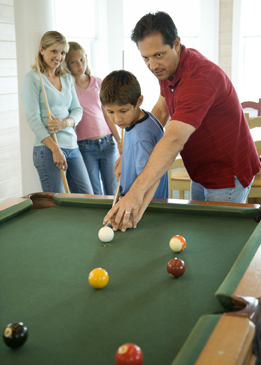Lesson 5
1. Lesson 5
1.7. Explore 3
Module 3: Permutations, Combinations, and the Fundamental Counting Principle
So far, you have seen that probabilities can be calculated using permutations and combinations. It is important to choose whether to use permutations or combinations correctly. Complete Try This 3 to explore this idea.
Try This 3

Hemera/Thinkstock
Nine-ball is a pocket billiard game that uses balls numbered from 1 to 9 and a white cue ball. The object of the game is to sink the ball labelled 9 into a pocket. Each time a player shoots, the cue ball must strike the lowest numbered ball on the table first. Once the 9 is sunk, the game ends—even if other balls are still on the table.
Ignore the cue ball (white ball) for the following questions.
- This photo shows how the balls are aligned or “racked” before the game begins.
Hemera/Thinkstock
Suppose the balls are racked at random and you want to determine the probability that they will be in the arrangement shown in the picture.- Can you use permutations to solve the problem? Explain.
- Can you use combinations to solve the problem? Explain.
- Calculate the probability. Note: Completing a chart similar to the following may help you calculate the probability.
Solution Description Decide if order is important for this question. Determine the number of favourable outcomes. Determine the number of total outcomes. Determine the probability.
- To set up the balls properly, the 1 must be at the front and the 9 must be at the centre as shown in the picture for question 1. Suppose the balls are aligned at random and you want to determine the probability the rack will be a useable setup.
- Can you use permutations to solve the problem? Explain.
- Can you use combinations to solve the problem? Explain.
- Determine the probability. Again, you might find it helpful to create a chart and complete it.
- Suppose three balls have been pocketed, with none of them being the number 9 ball. Determine the probability that all the pocketed balls have a value greater than the number 3 ball.
- Can you use permutations to solve the problem? Explain.
- Can you use combinations to solve the problem? Explain.
- Determine the probability that all the pocketed balls have a value greater than the number 3 ball.
![]() Save your responses in your course folder.
Save your responses in your course folder.
Share 2
With a partner or group, discuss the following based on what you discovered in Try This 3.
- How did you decide when a permutation or a combination was the appropriate method to use in Try This 3?
- Try This 3 question 3 may be determined using a permutation or a combination. Try to solve it again using a different method than you first tried.